Baker R.C. Flow Measurement Handbook: Industrial Designs, Operating Principles, Performance, and Applications
Подождите немного. Документ загружается.

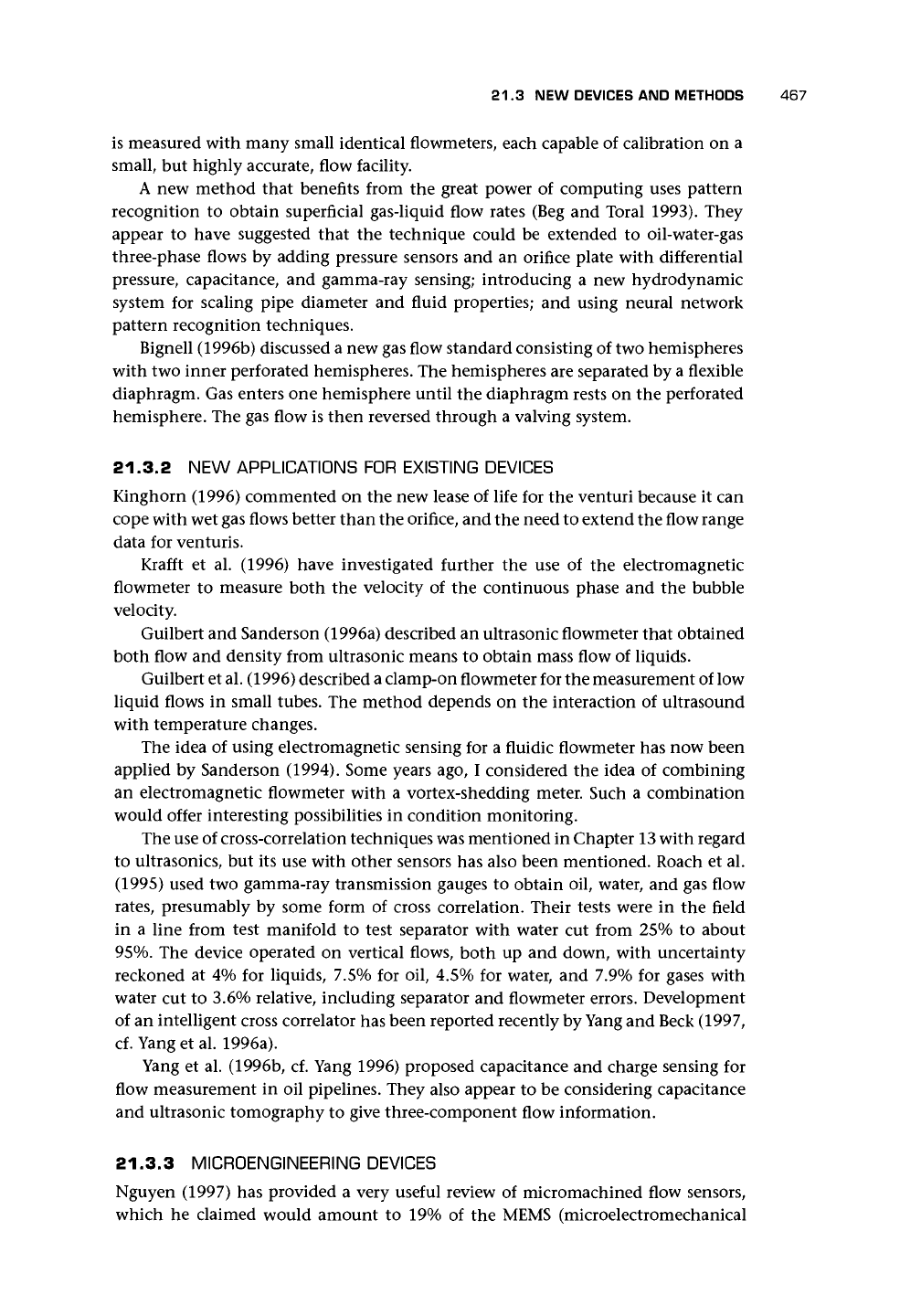
21.3 NEW DEVICES AND METHODS 467
is measured with many small identical flowmeters, each capable of calibration on a
small, but highly accurate, flow facility.
A new method that benefits from the great power of computing uses pattern
recognition to obtain superficial gas-liquid flow rates (Beg and Toral 1993). They
appear to have suggested that the technique could be extended to oil-water-gas
three-phase flows by adding pressure sensors and an orifice plate with differential
pressure, capacitance, and gamma-ray sensing; introducing a new hydrodynamic
system for scaling pipe diameter and fluid properties; and using neural network
pattern recognition techniques.
Bignell (1996b) discussed a new gas flow standard consisting of two hemispheres
with two inner perforated hemispheres. The hemispheres are separated by a flexible
diaphragm. Gas enters one hemisphere until the diaphragm rests on the perforated
hemisphere. The gas flow is then reversed through a valving system.
21.3.2
NEW
APPLICATIONS
FOR
EXISTING DEVICES
Kinghorn (1996) commented on the new lease of life for the venturi because it can
cope with wet gas flows better than the orifice, and the need to extend the flow range
data for Venturis.
Krafft et al. (1996) have investigated further the use of the electromagnetic
flowmeter to measure both the velocity of the continuous phase and the bubble
velocity.
Guilbert and Sanderson (1996a) described an ultrasonic flowmeter that obtained
both flow and density from ultrasonic means to obtain mass flow of liquids.
Guilbert et
al.
(1996) described a clamp-on flowmeter for the measurement of low
liquid flows in small tubes. The method depends on the interaction of ultrasound
with temperature changes.
The idea of using electromagnetic sensing for a fluidic flowmeter has now been
applied by Sanderson (1994). Some years ago, I considered the idea of combining
an electromagnetic flowmeter with a vortex-shedding meter. Such a combination
would offer interesting possibilities in condition monitoring.
The use of cross-correlation techniques was mentioned in Chapter
13
with regard
to ultrasonics, but its use with other sensors has also been mentioned. Roach et al.
(1995) used two gamma-ray transmission gauges to obtain oil, water, and gas flow
rates,
presumably by some form of cross correlation. Their tests were in the field
in a line from test manifold to test separator with water cut from 25% to about
95%.
The device operated on vertical flows, both up and down, with uncertainty
reckoned at 4% for liquids, 7.5% for oil, 4.5% for water, and 7.9% for gases with
water cut to 3.6% relative, including separator and flowmeter errors. Development
of an intelligent cross correlator has been reported recently by Yang and Beck (1997,
cf. Yang et al. 1996a).
Yang et al. (1996b, cf. Yang 1996) proposed capacitance and charge sensing for
flow measurement in oil pipelines. They also appear to be considering capacitance
and ultrasonic tomography to give three-component flow information.
21.3.3 MICROENGINEERING DEVICES
Nguyen (1997) has provided a very useful review of micromachined flow sensors,
which he claimed would amount to 19% of the MEMS (microelectromechanical

468
FUTURE DEVELOPMENTS
systems) market by 2000, over
US
$2.5 billion. The first sensor based on silicon tech-
nology appeared in the 1970s. The result of this technology is new applications such
as the measurement of acoustical flow in a thermal microphone. Nguyen divides the
sensors into two categories: nonthermal and thermal. The nonthermal sensors use
drag force on a cantilever, pressure drop measured with capacitive or piezoresistive
sensors, and Coriolis force. Nguyen also suggested that a microturbine and a bistable
fluidic element are also possible. The thermal sensors use hot-wire/hot-films, calori-
metric sensors similar to the thermal flowmeter or time-of-flight techniques. The
reader is referred to the article, which gives useful diagrams and characteristics of
the meters. Nguyen suggested that an integrated analogue-to-digital converter on
the chip would be useful. The combination of these devices with bypass methods
would seem to be very powerful.
Legtenberg et al. (1991) described a resonating microbridge mass flow sensor,
which was suspended inside a micro flow channel. Thin film technologies and mi-
cromachining were used for the fabrication of the sensor wafer and a cap wafer
with opposing V-grooves. A low-temperature glass-bonding technique was used to
assemble the wafers, allowing for feed-through of the electrical connections. Mea-
surements showed sensitivities of the resonance frequency of several kHz/cm
3
for
nitrogen gas flows at average temperature elevations of the microbridge in the range
20-100°C. Figure 21.1 gives a clear view of the device. Flow of gas past the heated
structure will change the resonant frequency. Thermal excitation and piezoresistive
detection are used to induce and measure the vibrations.
Jitschin et al. (1995) described a very small orifice with a nominal diame-
ter of 100 /xm and operating in the molecular flow regime for applications in
ultra-high-vacuum technology, van der Wiel et al. (1993) developed a silicon
sensor and made it using industrial bipolar process and micromachining. It de-
pends on convective heat transfer resulting from the liquid flow. Because it is
designed for use in biomedical flows up to 2 m/s, the temperature differences
are l-10°C, and the sensitivity is 10 mV/
(m/s).
The overall dimensions of the chip
are 2.0 mm x 1.6 mm x 0.4 mm, which
includes the heater and the diodes for tem-
perature measurement.
Another low cost silicon sensor (Nguyen
and Kiehnscherf 1995) produced through
microtechnology for mass flow measure-
ment of liquids and gases is shown in Figure
21.2.
Its operation is based on heat transfer
to the flow from heated resistors in the flow-
ing fluid and the consequent temperature
difference of the sensors in the flow. The
range is 0-500 ml/min for gases and 0-10
or 0-500 ml/min for liquids.
van Oudheusen
(1991,
1992; a very
useful and thorough treatment of this
developing area to which the reader is
referred) developed a direction-sensitive
Figure 21.1. Resonating microbridge mass flow sen-
sor. The channel height is 420 /xm (reproduced from
Legtenberg et al. 1991 with permission of Elsevier
Science Ltd.).
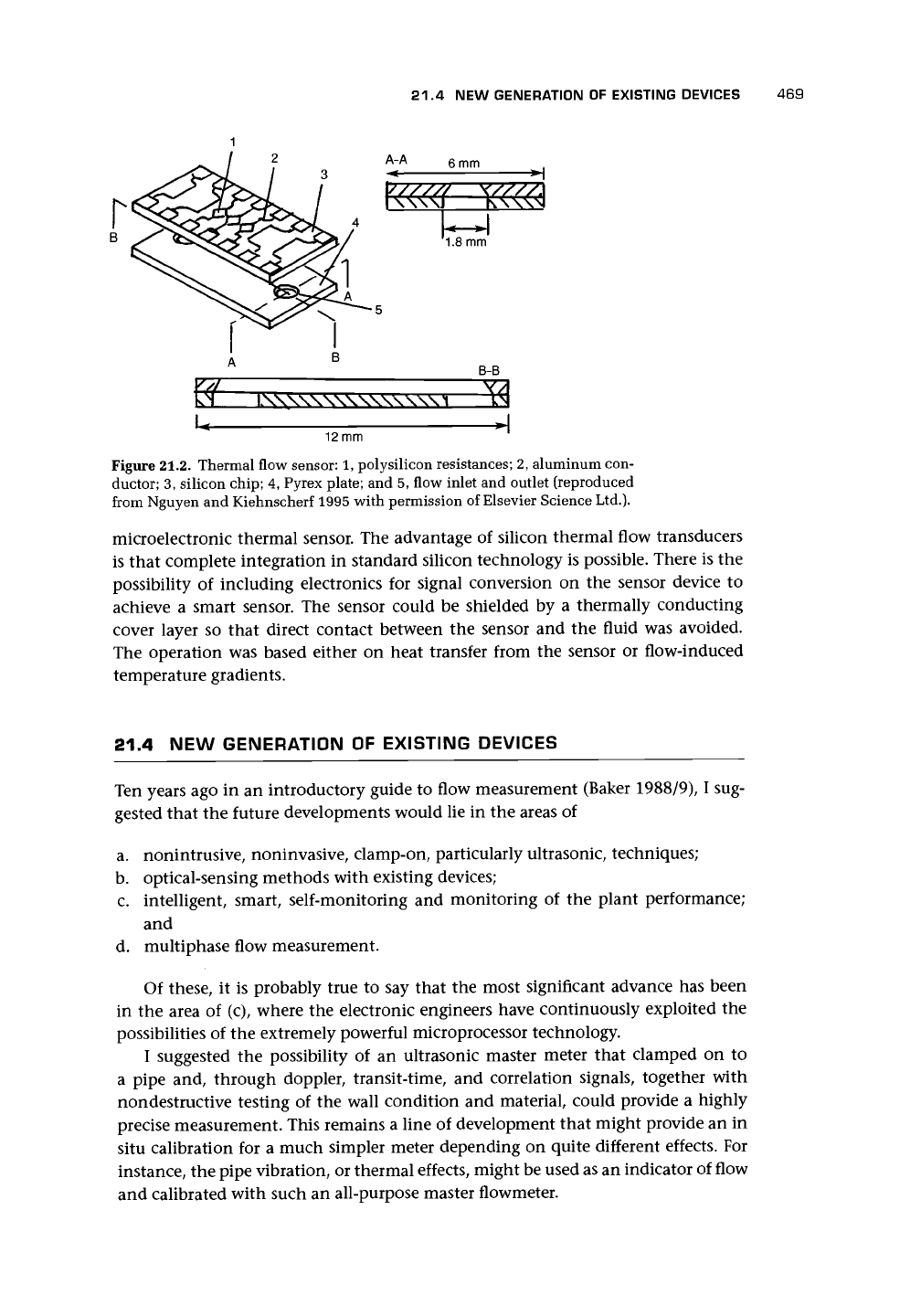
21.4 NEW GENERATION OF EXISTING DEVICES
469
2
A
~A 6
mm
3
^
ys///( VWV3
1.8
mm
B-B
12
mm
Figure 21.2. Thermal flow sensor: 1, polysilicon resistances; 2, aluminum con-
ductor; 3, silicon chip; 4, Pyrex plate; and 5, flow inlet and outlet (reproduced
from Nguyen and Kiehnscherf 1995 with permission of Elsevier Science Ltd.).
microelectronic thermal sensor. The advantage of silicon thermal flow transducers
is that complete integration in standard silicon technology is possible. There is the
possibility of including electronics for signal conversion on the sensor device to
achieve a smart sensor. The sensor could be shielded by a thermally conducting
cover layer so that direct contact between the sensor and the fluid was avoided.
The operation was based either on heat transfer from the sensor or flow-induced
temperature gradients.
21.4 NEW GENERATION OF EXISTING DEVICES
Ten years ago in an introductory guide to flow measurement (Baker 1988/9), I sug-
gested that the future developments would lie in the areas of
a. nonintrusive, noninvasive, clamp-on, particularly ultrasonic, techniques;
b.
optical-sensing methods with existing devices;
c. intelligent, smart, self-monitoring and monitoring of the plant performance;
and
d. multiphase flow measurement.
Of these, it is probably true to say that the most significant advance has been
in the area of (c), where the electronic engineers have continuously exploited the
possibilities of the extremely powerful microprocessor technology.
I suggested the possibility of an ultrasonic master meter that clamped on to
a pipe and, through doppler, transit-time, and correlation signals, together with
nondestructive testing of the wall condition and material, could provide a highly
precise measurement. This remains a line of development that might provide an in
situ calibration for a much simpler meter depending on quite different effects. For
instance, the pipe vibration, or thermal effects, might be used as an indicator of flow
and calibrated with such an all-purpose master flowmeter.

470 FUTURE DEVELOPMENTS
Optical methods have clearly moved
on
substantially in 10 years, although their
direct use
in
process sensors is
an
area
for
further development. With Morris (1983),
I reviewed the suitability
of
flowmeters
for
optical sensing, and more recently Dick-
inson (1988) considered design
of
optical flowmeter sensors. His paper has examples
of variable area, turbine, thermal,
and
cross correlation. Dickinson suggested that
a
noninvasive pickup
to
sense rotation
in
turbine and positive displacement without
any moment/movement would
be
useful,
as
would
the
development
of a
vortex
meter using optical methods
for
steam.
I have already commented
on the
needs
for
more development
in
the
area
of
multiphase, particularly subsea, flows.
The new areas that I would add
to
the preceding list are
• Mass meters
for
gases.
I
have already referred
to
this
and
suspect that
it
lies
in
the
improvement
of
thermal
and
ultrasonic methods, possibly linked
to-
gether.
• Microsensors. Here
the
possibilities appear
to be
very exciting and,
if
used
as
bypass flowmeters, very extensive.
21.5 IMPLICATIONS
OF
INFORMATION TECHNOLOGY
21.5.1
SIGNAL ANALYSIS
The idea that
the
signal,
far
from being smoothed, contains data that
can
reveal
information about
the
meter
and the
process (Amadi-Echendu
and
Higham 1990,
Amadi-Echendu
and
Hurren
1990)
is an
important insight.
It
suggests that
the
noise
may
carry
a
fingerprint
of
the
meter
and may be
interpreted
by
powerful
computational methods
to
indicate change, possibly correction factors
and
indeed
many other factors. However,
if
this is
to
be fully realized,
it
is essential that models
linking
the
flowmeter/flow system behavior with
the
noise characteristics
be
developed,
to
give
a
firm theoretical basis. Cheesewright
et
al. (1998) have provided
an appropriate caution.
21.5.2
REDESIGN ASSUMING MICROPROCESSOR TECHNOLOGY
An intriguing question
to ask
is: what would have been
the
design
of
flowmeters,
which
are
now dominated
by
mechanical engineering,
if
the
power
of the
micro-
processor
had
been available?
For
instance,
the
"fingerprint"
of the
vibration
of a
pipe might
be
stored
in the
microprocessor
for
various flow rates
and be
used
as
a
look-up table,
but
the actual sensor might be
a
simple vibration sensor.
21.5.3
CONTROL
There seems little doubt that
the
extraordinary developments
in
control,
and the
increasing flexibility will continue
in
the next 10 years
or
more.
For instance, by collecting data on correct plant operation, together with models
of the plant flows,
and by
checking current flows against
the
data
and
model,
any
plant changes (e.g., occurrence
of
leaks) can be identified (Valenti 1995).

21.7 THE WAY AHEAD
471
21.5.4 RECORDS, MAINTENANCE,
AND
CALIBRATION
Yeung
et
al. (1994) reported
on a
detailed survey
of
the use
of
insertion meters
in
collaboration with four water utilities and six consultancy companies
in
the United
Kingdom. There were deficiencies
in
records, equipment maintenance and calibra-
tion, work instructions, and training. There was also
a
difference
in
perception be-
tween management and the technicians, and an ignorance about the ownership and
maintenance
of
records.
There
is
clearly
a
need
for
training
in
essential information such
as
standard
documents and their requirements. This
is an
area where modern information and
communication methods, particularly linked with modern control, should ensure
that much documentation
is
automatically produced. Gallagher (1992) also raised
the issue
of
certification
of
technicians.
21.6 CHANGING APPROACHES
TO
MANUFACTURING
AND PRODUCTION
This book
has not
pretended
to
give guidance
in the
area
of
manufacturing
and
production. However,
a
key change
in
recent thinking has been the use
of
cell man-
ufacture and the consequent increase
of
ownership and responsibility by the team
in
the
cell.
In the
area
of
instrumentation,
I
have suggested that there
is
room
for
careful understanding
of
the links between production methods and instrument ac-
curacy.
It is an
area where precise measurement
of
the production process,
and of
the product as
it
moves through the process, is needed and where new methods are
likely
to
be developed.
21.7
THE
WAY AHEAD
21.7.1 FOR THE
USER
The competition
in
the market place is fierce, and the products vary in performance
and quality. Time spent,
and
advice sought,
on
the best device
for a
particular ap-
plication may save much time and money
in
the next 10 years.
21.7.2
FOR THE
MANUFACTURER
The ability
to
tailor the product
to
the user's needs, the opportunity
for
the user
to
send
an
order
by
modern communication (e-mail, etc.),
and the
ability
to
deliver
this special order
in
days
or
even hours,
is
possible,
and
some manufacturers
are
achieving remarkable order-to-delivery times. Staying in business requires that steps
be taken
to
achieve this.
In
the process,
it
is likely to lead to the rethinking
of
many
aspects
of
production
to the
benefit
of the
company,
and if all the
work force
is
involved,
to
their benefit also.
21.7.3
FOR THE
INCUBATOR COMPANY
New start-up companies
run by an
entrepreneur with
a
brilliant new concept
are
to
be
encouraged,
but in
this competitive market, they will need support. Such
support exists
and is
likely
to be
more widely available
as
time passes.
At its
best,
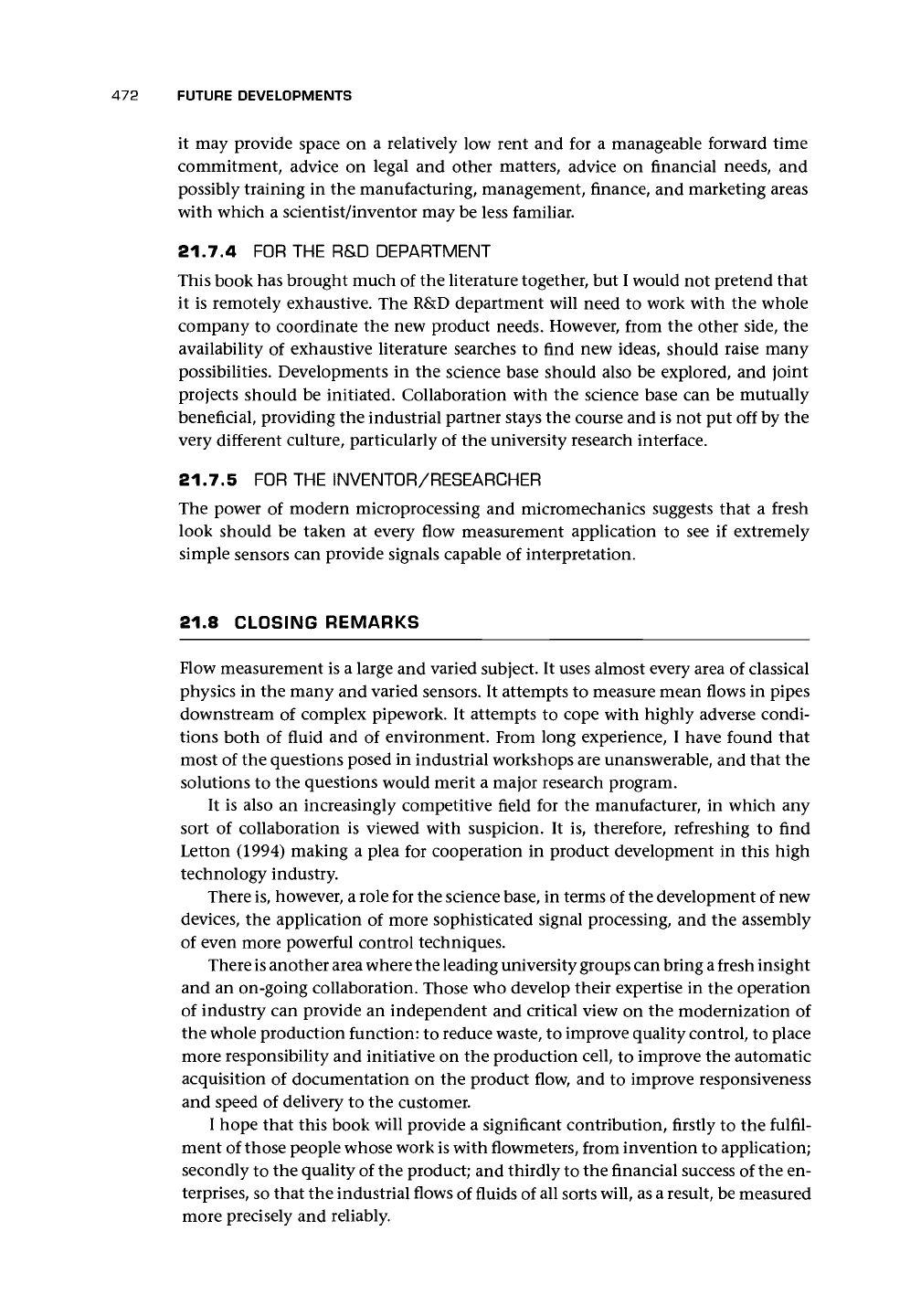
472 FUTURE DEVELOPMENTS
it may provide space on
a
relatively low rent and for
a
manageable forward time
commitment, advice
on
legal and other matters, advice
on
financial needs, and
possibly training in the manufacturing, management, finance, and marketing areas
with which a scientist/inventor may be less familiar.
21.7.4
FOR THE R&D DEPARTMENT
This book has brought much of the literature together, but I would not pretend that
it is remotely exhaustive. The R&D department will need to work with the whole
company to coordinate the new product needs. However, from the other side, the
availability
of
exhaustive literature searches
to
find new ideas, should raise many
possibilities. Developments
in
the science base should also be explored, and joint
projects should be initiated. Collaboration with the science base can be mutually
beneficial, providing the industrial partner stays the course and is not put off by the
very different culture, particularly of the university research interface.
21.7.5
FOR THE INVENTOR/RESEARCHER
The power
of
modern microprocessing and micromechanics suggests that
a
fresh
look should be taken
at
every flow measurement application
to
see
if
extremely
simple sensors can provide signals capable of interpretation.
21.8 CLOSING REMARKS
Flow measurement is a large and varied subject. It uses almost every area of classical
physics in the many and varied sensors. It attempts to measure mean flows in pipes
downstream of complex pipework.
It
attempts to cope with highly adverse condi-
tions both
of
fluid and
of
environment. From long experience,
I
have found that
most of the questions posed in industrial workshops are unanswerable, and that the
solutions to the questions would merit a major research program.
It is also an increasingly competitive field for the manufacturer,
in
which any
sort
of
collaboration
is
viewed with suspicion.
It
is, therefore, refreshing
to
find
Letton (1994) making
a
plea for cooperation in product development in this high
technology industry.
There
is,
however, a role for the science
base,
in terms of the development of new
devices, the application of more sophisticated signal processing, and the assembly
of even more powerful control techniques.
There
is
another area where the leading university groups can bring
a
fresh insight
and an on-going collaboration. Those who develop their expertise in the operation
of industry can provide an independent and critical view on the modernization of
the whole production function: to reduce waste, to improve quality control, to place
more responsibility and initiative on the production cell, to improve the automatic
acquisition of documentation on the product flow, and to improve responsiveness
and speed of delivery to the customer.
I hope that this book will provide a significant contribution, firstly to the fulfil-
ment of those people whose work is with flowmeters, from invention to application;
secondly to the quality of the product; and thirdly to the financial success of the en-
terprises, so that the industrial flows
of
fluids
of all sorts will, as a result, be measured
more precisely and reliably.
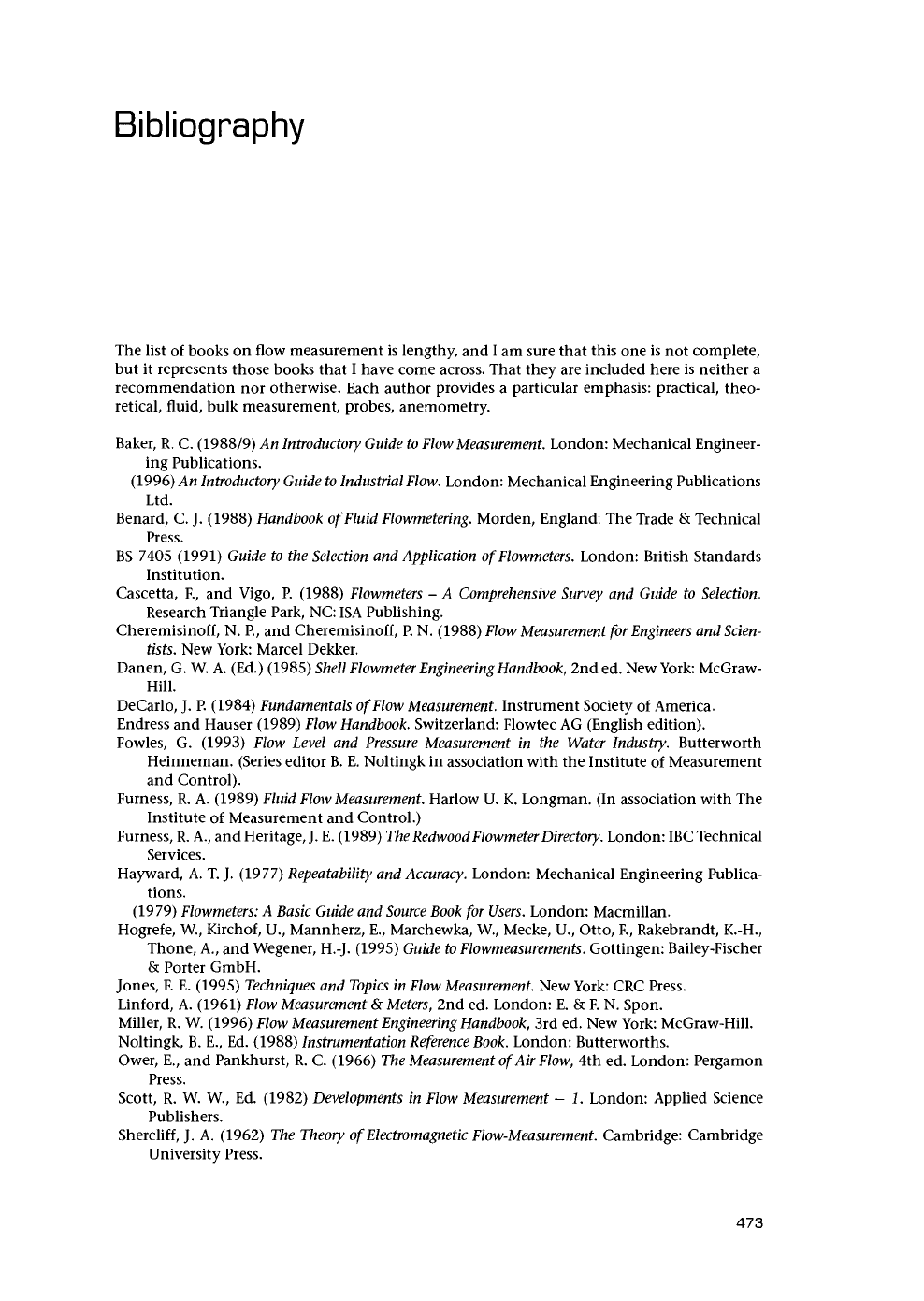
Bibliography
The list of books on flow measurement is lengthy, and I am sure that this one is not complete,
but it represents those books that I have come across. That they are included here is neither a
recommendation nor otherwise. Each author provides a particular emphasis: practical, theo-
retical, fluid, bulk measurement, probes, anemometry.
Baker, R. C. (1988/9) An
Introductory Guide to Flow
Measurement.
London: Mechanical Engineer-
ing Publications.
(1996) An
Introductory Guide to Industrial
Flow.
London: Mechanical Engineering Publications
Ltd.
Benard, C. J. (1988)
Handbook
of
Fluid
Flowmetering.
Morden, England: The Trade & Technical
Press.
BS 7405 (1991)
Guide
to the
Selection
and
Application
ofFlowmeters.
London: British Standards
Institution.
Cascetta, R, and Vigo, P. (1988)
Flowmeters
- A
Comprehensive Survey
and Guide to
Selection.
Research Triangle Park,
NC:
ISA
Publishing.
Cheremisinoff,
N. P., and
Cheremisinoff,
P.
N. (1988)
Flow Measurement for Engineers
and
Scien-
tists.
New York: Marcel Dekker.
Danen, G. W. A. (Ed.) (1985)
Shell Flowmeter
Engineering
Handbook,
2nd ed. New
York:
McGraw-
Hill.
DeCarlo, J. P. (1984)
Fundamentals
of
Flow
Measurement.
Instrument Society of America.
Endress and Hauser (1989)
Flow
Handbook.
Switzerland: Flowtec AG (English edition).
Fowles, G. (1993) Flow Level and
Pressure
Measurement in the Water Industry. Butterworth
Heinneman. (Series editor
B.
E. Noltingk in association with the Institute of Measurement
and Control).
Furness, R. A. (1989)
Fluid Flow
Measurement.
Harlow U. K. Longman. (In association with The
Institute of Measurement and Control.)
Furness,
R.
A., and
Heritage,
J.
E.
(1989) The Redwood Flowmeter
Directory.
London:
IBC
Technical
Services.
Hayward, A.
T.
J. (1977)
Repeatability
and
Accuracy.
London: Mechanical Engineering Publica-
tions.
(1979)
Flowmeters:
A
Basic Guide
and
Source Book
for
Users.
London: Macmillan.
Hogrefe, W.,
Kirchof,
U., Mannherz, E., Marchewka, W., Mecke, U., Otto, E, Rakebrandt, K.-H.,
Thone, A., and Wegener, H.-J. (1995)
Guide to
Flowmeasurements.
Gottingen: Bailey-Fischer
& Porter GmbH.
Jones,
F.
E. (1995)
Techniques
and
Topics
in
Flow
Measurement.
New York: CRC Press.
Linford, A. (1961)
Flow Measurement &
Meters,
2nd ed. London: E. &
F.
N. Spon.
Miller, R. W. (1996)
Flow Measurement Engineering
Handbook,
3rd ed. New York: McGraw-Hill.
Noltingk, B. E., Ed. (1988)
Instrumentation Reference
Book.
London: Butterworths.
Ower, E., and Pankhurst, R. C. (1966)
The Measurement
of Air
Flow,
4th ed. London: Pergamon
Press.
Scott, R. W. W., Ed. (1982)
Developments
in
Flow Measurement
- 1. London: Applied Science
Publishers.
Shercliff,
J. A. (1962) The
Theory
of
Electromagnetic
Flow-Measurement.
Cambridge: Cambridge
University Press.
473

474 BIBLIOGRAPHY
Spink, L. K. (1978)
Principles
and
Practice
of
Flow Meter
Engineering,
9th ed. Foxboro MA : The
Foxboro Co.
Spitzer, D. W. (1990)
Industrial Flow
Measurement.
Instrument Society of America.
Spitzer, D. W.
;
Ed. (1991)
Flow
Measurement.
Instrument Society of America.
Upp,
E. L. (1993)
Fluid Flow
Measurement.
Houston: Gulf Publishing.
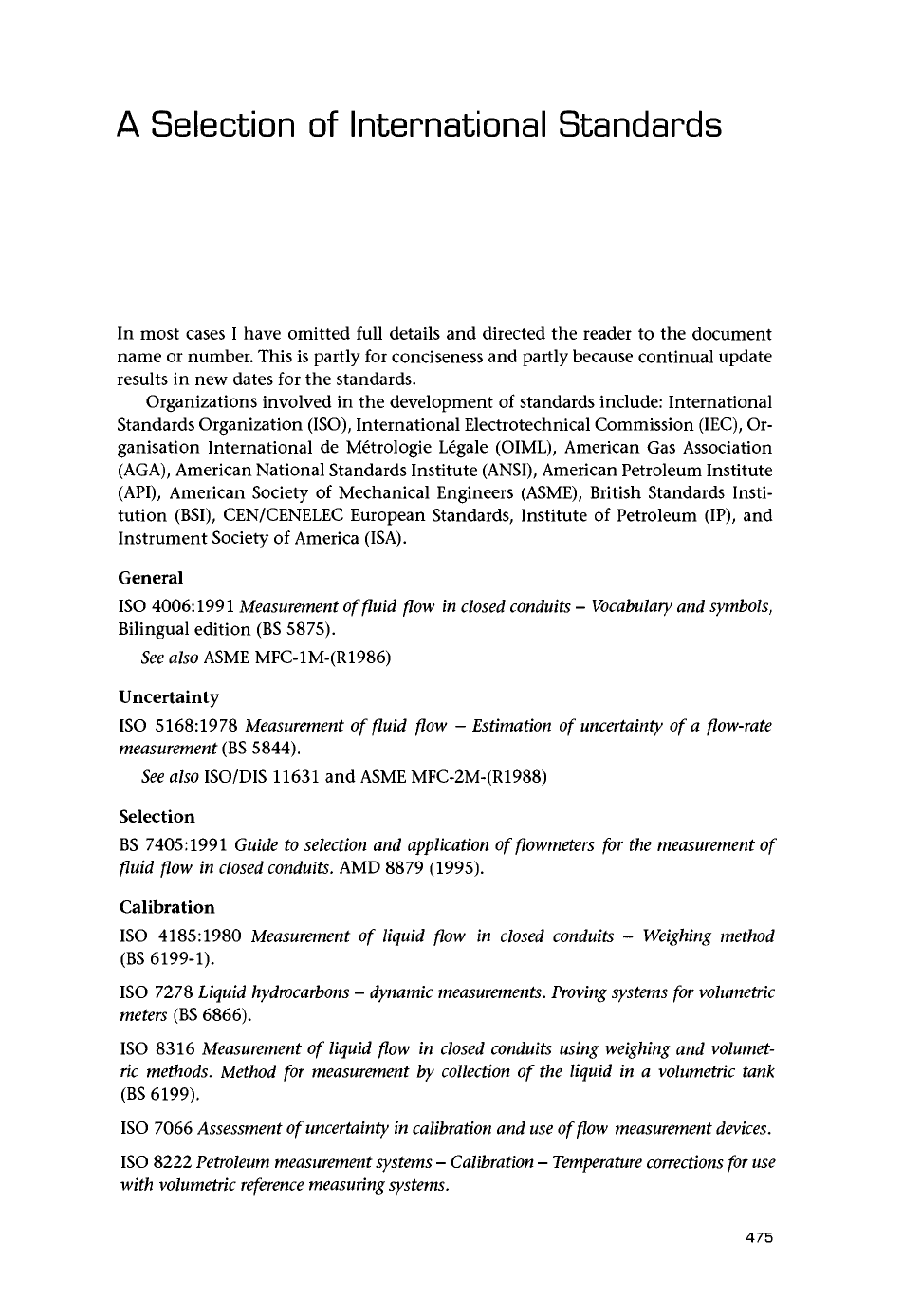
A Selection of International Standards
In most cases I have omitted full details and directed the reader to the document
name or number. This is partly for conciseness and partly because continual update
results in new dates for the standards.
Organizations involved in the development of standards include: International
Standards Organization (ISO), International Electrotechnical Commission (IEC), Or-
ganisation International de Metrologie Legale (OIML), American Gas Association
(AGA), American National Standards Institute (ANSI), American Petroleum Institute
(API),
American Society of Mechanical Engineers (ASME), British Standards Insti-
tution (BSI), CEN/CENELEC European Standards, Institute of Petroleum (IP), and
Instrument Society of America (ISA).
General
ISO 4006:1991 Measurement of fluid flow in closed conduits - Vocabulary and symbols,
Bilingual edition (BS 5875).
See also ASME MFC-1M-(R1986)
Uncertainty
ISO 5168:1978 Measurement of fluid flow - Estimation of uncertainty of a flow-rate
measurement (BS 5844).
See also ISO/DIS 11631 and ASME MFC-2M-(R1988)
Selection
BS 7405:1991 Guide to selection and application of flowmeters for the measurement of
fluid flow in closed conduits. AMD 8879 (1995).
Calibration
ISO 4185:1980 Measurement of liquid flow in closed conduits - Weighing method
(BS 6199-1).
ISO 7278 Liquid hydrocarbons - dynamic measurements. Proving systems for volumetric
meters (BS 6866).
ISO 8316 Measurement of liquid flow in closed conduits using weighing and volumet-
ric methods. Method for measurement by collection of the liquid in a volumetric tank
(BS 6199).
ISO 7066 Assessment of uncertainty in calibration and use of flow measurement devices.
ISO 8222 Petroleum measurement systems - Calibration - Temperature corrections for use
with volumetric reference measuring systems.
475
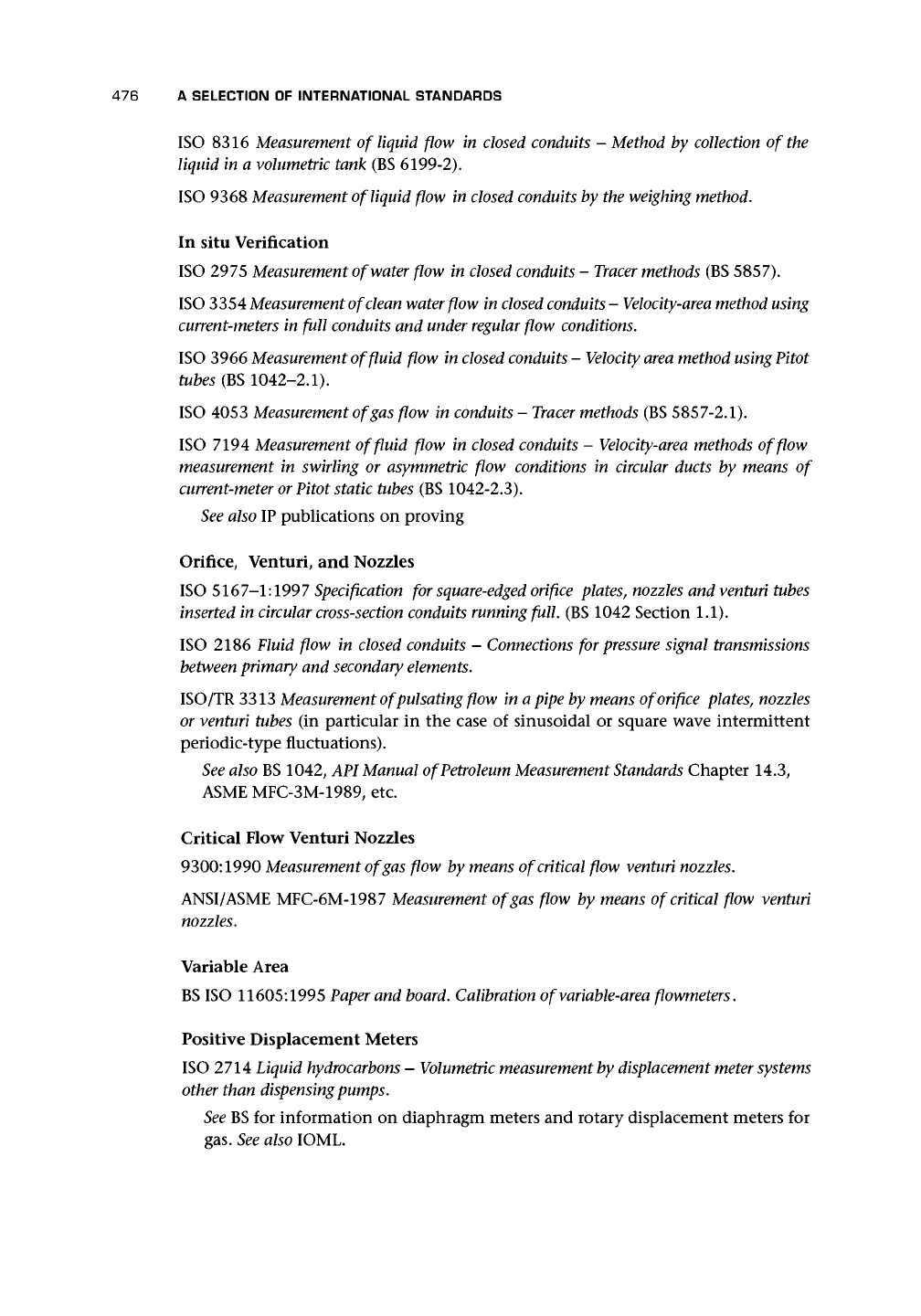
476 A SELECTION OF INTERNATIONAL STANDARDS
ISO 8316 Measurement of
liquid
flow in
closed
conduits - Method by
collection
of the
liquid in a
volumetric
tank (BS 6199-2).
ISO 9368
Measurement
of
liquid
flow in
closed conduits
by the
weighing
method.
In situ Verification
ISO 2975
Measurement
of
water
flow in
closed conduits
-
Tracer methods
(BS
5857).
ISO 3354 Measurement of
clean water flow
in
closed conduits
-
Velocity-area method using
current-meters
in full
conduits
and
under regular
flow conditions.
ISO 3966
Measurement
of fluid flow in
closed conduits
-
Velocity area
method
using Pitot
tubes (BS 1042-2.1).
ISO 4053
Measurement
of gas flow in
conduits
-
Tracer methods
(BS 5857-2.1).
ISO 7194
Measurement
of fluid flow in
closed conduits
-
Velocity-area
methods of flow
measurement in swirling or asymmetric flow conditions in
circular
ducts by means of
current-meter or Pitot static tubes
(BS 1042-2.3).
See also
IP publications on proving
Orifice, Venturi, and Nozzles
ISO 5167-1:1997
Specification
for
square-edged orifice
plates, nozzles and
venturi
tubes
inserted
in
circular cross-section conduits running
full.
(BS 1042 Section 1.1).
ISO 2186 Fluid flow in
closed conduits
-
Connections
for
pressure
signal transmissions
between primary
and
secondary
elements.
ISO/TR 3313
Measurement
of pulsating
flow
in
a pipe
by
means
of
orifice
plates, nozzles
or venturi tubes (in particular in the case of sinusoidal or square wave intermittent
periodic-type fluctuations).
See also
BS
1042,
API
Manual
of
Petroleum Measurement Standards
Chapter 14.3,
ASME MFC-3M-1989, etc.
Critical Flow Venturi Nozzles
9300:1990
Measurement
of gas flow by means of
critical
flow
venturi
nozzles.
ANSI/ASME MFC-6M-1987
Measurement
of gas flow by means of
critical
flow venturi
nozzles.
Variable Area
BS ISO 11605:1995
Paper
and
board.
Calibration
of
variable-area
flowmeters.
Positive Displacement Meters
ISO 2714 Liquid
hydrocarbons
-
Volumetric measurement
by
displacement meter systems
other
than dispensing pumps.
See BS
for information on diaphragm meters and rotary displacement meters for
gas.
See also
IOML.
